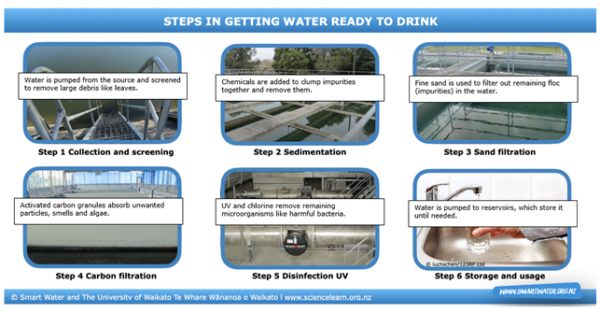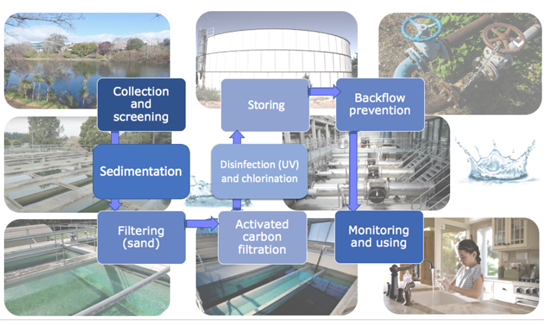ACTIVITY
Getting water ready to drink
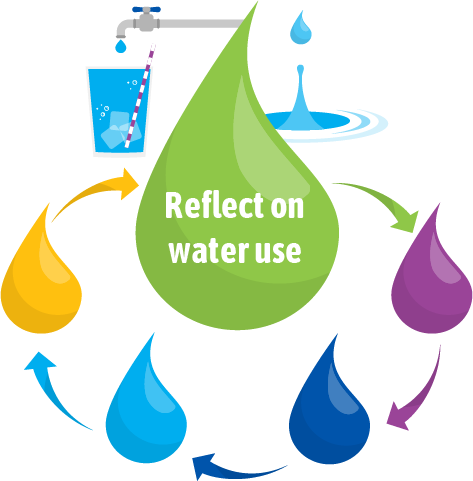
Curriculum links : Levels 3-4
Science: Material World: Chemistry and society
Nature of Science: Communicating in Science
Technology: Technological Knowledge; technological systems
Nature of Technology: Characteristics of technology
Activity Idea
In this activity, students learn about water treatment processes for drinking water in Waikato. Explore the steps in the process and the inputs and outputs.
By the end of this activity, students should be able to:
- order the steps in the drinking water treatment process
- describe the purposes of water treatment
What you need
- Getting Water Ready to Drink - Activity 6 doc
- Video: Smart Water tour of your treatment plant video with Hamilton City Council water sources
- Video: Turn dirty water into clean Water! | Chirp Science Corner
- A selection of materials that may include dirty water (stream water, water with soil and a few tea bags added or similar), buckets, cups, sieves, coffee filters, gravel of different sizes, sand, cotton balls or cotton material
- Student handout Information about water treatment processes
- Steps in getting water ready to drink online interactive or the paper-based student handout Steps in the drinking water treatment process
FOR TEACHERS
Introduction
Drinking water in the Waikato region is currently provided by local councils. Councils such as Hamilton City Council, Waipā District Council and Waitomo District Council have resource consents (permissions) to take water from a source and treat it to provide healthy drinking water for their local communities. Most people in Waikato are connected to a town supply to source their water.
The drinking water treatment process and collection methods are similar for each area but can differ slightly according to the water source and where you live. Water is collected from a natural source, then has to go through a treatment process.
Treating drinking water is a complex and expensive task, requiring many resources.
Why do we need to treat drinking water?
Water from natural sources can contain harmful bacteria, parasites and germs. Parasites such as Giardia and Cryptosporidium and bacteria like Salmonella can make people very sick. At a water treatment plant, these parasites, bacteria, impurities, bugs and chemicals are removed by a variety of different effective methods to make water safe to drink.
The drinking water treatment process for Waikato locations
Water for Hamilton City is sourced from the Waikato River and treated at Hamilton City Council’s water treatment plant. Every second of every day, this water treatment plant converts 2,500 glasses of river water into first-rate drinking water for 50,000 homes and businesses!
For more information, see Hamilton City Council’s website and read A guide to Hamilton’s water supply: River to the tap.
For information about drinking water in Waipā and Waitomo, see:
Waipā District Council – water treatment and supply
Waitomo District Council – water services.
Rain harvesting, bores and other water sources
There are a variety of ways to source water and maintain water quality.
Rainwater tanks that collect rain from roofs and gutters can be a source of water supply for people in New Zealand. This is called rain harvesting. Some families have permission to use a pump system to pump water from a stream to their house. Many farms have a bore or well that takes water from groundwater below the ground.
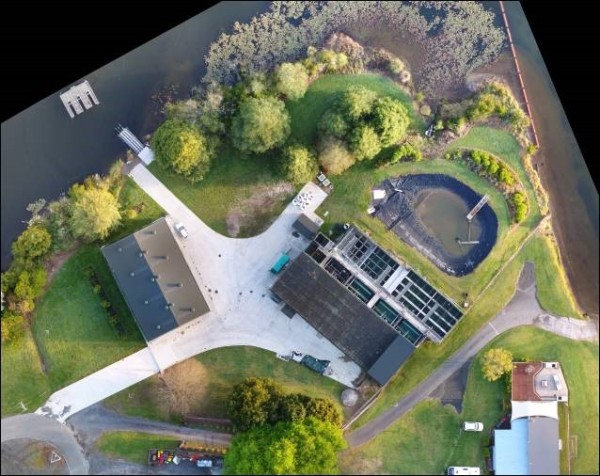
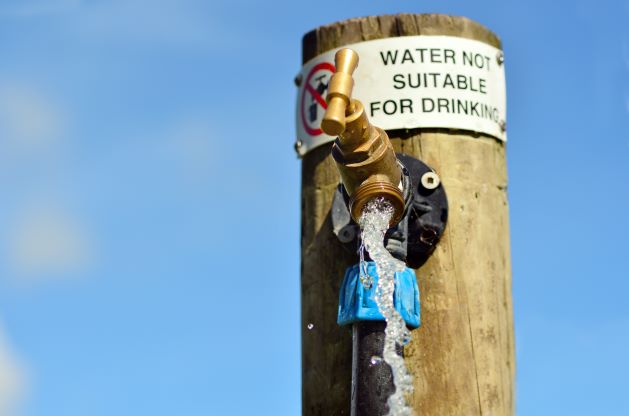
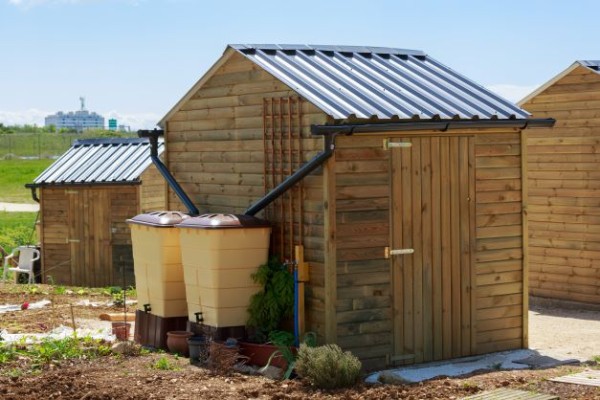
Introducing drinking water
1. Show students a glass of tap water. Ask them what they think is involved in getting this clean drinking water to their taps. Where does it come from (the source) and which processes does it go through from source through to distribution and use?
2. View the video Smart Water tour of your treatment plant video with Hamilton City Council water sources. Key moments in this video:
- Collection from intake – 04:31
- Sedimentation and coagulation – 06:22
- Filtration – sand filters – 07:53
- Granular activated carbon filtration – 09:10
- Disinfection (UV) and chlorination – 10:09
3. After viewing, discuss the steps in the drinking water treatment process.
4. Investigate the steps in the process in more detail with the student handout Information about water treatment processes.
Filtering and cleaning water activity
6. Explore water treatment and filtering processes with an open experiment.
7. Provide students with a variety of materials such as buckets, cups, sieves, coffee filters, gravel of different sizes, sand, cotton balls and/or cotton material.
8. Start with a glass of dirty water (stream water, water with soil and a few tea bags added or similar) and challenge groups of students to use their materials to set up processes on a small scale that will clean the water as much as possible. This could be a challenge to obtain the clear clean-looking water. Watch the video Turn dirty water into clean water! | Chirp Science Corner for ideas.
Drinking water treatment
9. Review the steps in the drinking water treatment process. Use the interactive Steps in getting water ready to drink or use the paper copy in the student handout. Use the video Smart Water tour of your treatment plant video with Hamilton City Council water sources and the student handout Information about water treatment processes to help with placement. The correct steps are shown in the graphic on the page.
Questions for deeper thinking
- Why is it necessary for drinking water to go through all of these steps of treatment before being distributed to consumers?
- Thinking about all the effort, time and resources it takes to treat water to make it safe to drink, does this make you think differently about the water coming out of your tap?
- Do we need to use drinkable water for tasks such as washing the car, watering the garden or flushing the toilet? What would the alternatives be? How can we be smarter with how we use tap water?
Reflecting on learning
- Why does water need to be treated before drinking?
- How is water transformed by the processes of water treatment?
Extension idea
Find out how some of our daily interactions can impact on our local waterways with Our use of water – impacts on water quality.
This activity is part of a suite of resources that support Smart Water – a context for learning, which provides students and teachers with opportunities to connect with water and learn more about drinking water in the Waikato region. The science and mātauranga concepts that underpin Smart Water are transferable to other locations in Aotearoa New Zealand. Smart Water is a partnership between Hamilton City Council, Waipā District Council and Waitomo District Council. It aims to foster a greater understanding and appreciation of water from source to tap and supports schools, organisations and communities to use water sustainably.
Information about water treatment processes
Information about water treatment processes
|
In the environment |
Inside the water treatment plant |
In the community |
|||||
|---|---|---|---|---|---|---|---|
|
1 |
2 |
3 |
4 |
5 |
6 |
7 |
8 |
|
Screening |
Sedimentation |
Filtration (sand) |
Carbon filtration |
Disinfection (UV) and chlorination |
Storing |
Backflow prevention |
Monitoring and using water |
|
Water is collected from a source, such as a river. It then passes through metal grates and large screens. These make sure twigs, rubbish, weeds and other items don’t get into the treatment plant. |
Special chemicals are added to water to clump the impurities together to make floc. The floc separates from the water in a layer, making it easier to remove. Special tanks are used that help to separate floc from the water. Floc is sucked out of the tanks and put into the wastewater system. |
Fine sand is used to filter out remaining floc in the water. Water on top passes through the sand filters below via the force of gravity, removing any remaining floc or microbes such as Giardia |
Activated carbon granules absorb any remaining unwanted particles, odours or algae. Each grain of carbon is covered in tiny holes that absorb unwanted dissolved material. |
Disinfection by UV light treats the remaining water, zapping any tiny bugs that may have been missed. Chlorine is then added to kill any other viruses, bacteria or particles that have escaped the treatment process. Some chlorine remains in water as it leaves the treatment plant to make sure it stays clean on its journey. |
The treated water leaves the treatment plant through large pipes called water mains. Treated water is stored in large tanks called reservoirs around the city. Water sits in the reservoirs until needed. |
Backflow preventers are connected at multiple stages of the treatment process to prevent treated water from flowing back to previous steps in the system. This is important in case of emergencies. |
Water leaving the treatment plant and in reservoirs is monitored and tested regularly to make sure it is 100% safe for drinking. Treated safe drinking water then travels through pipes to homes and buildings for use. |
|
SHORT VERSION |
|||||||
|
Water goes through metal grates and large screens, removing rubbish and plant material. |
Adding chemicals to clump impurities together as floc and removing them.
|
Fine sand is used to filter out remaining floc or germs in the water. |
Activated carbon granules absorb unwanted particles, smells or algae. |
UV and chlorine treat any remaining microbes. |
Water is stored in reservoirs until needed. |
Backflow preventers stop any water flowing backwards in the treatment process. |
Treated water is carefully monitored, then piped to buildings and used by people. |
Steps in getting water ready to drink
The descriptions of the steps in the drinking water treatment process are listed in a random order. Cut out the descriptions and place them where they belong in the graphic organiser.
|
Activated carbon granules absorb unwanted particles, smells and algae.
|
Water is pumped from the source and screened to remove large debris like leaves. |
Chemicals are added to clump impurities together and remove them. |
|
Water is pumped to reservoirs, which store it until needed.
|
Fine sand is used to filter out remaining floc (impurities) in the water. |
UV and chlorine remove remaining microorganisms like harmful bacteria. |
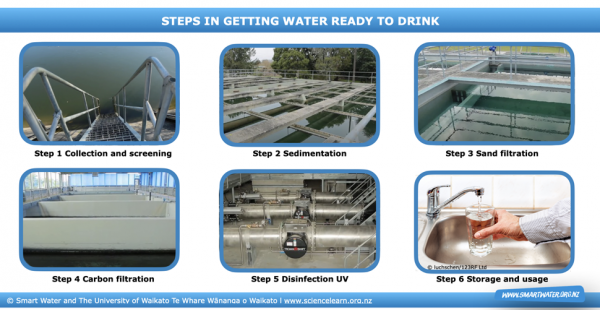
Steps in getting water ready to drink
Cut and paste/or drag and drop the process steps of drinking water treatment (on the left) into the correct order on the diagram.
ADDITIONAL RESOURCES
Activities
Media
- Smart Water tour of your treatment plant video with Hamilton City Council water sources
- Turn dirty water into clean Water!
